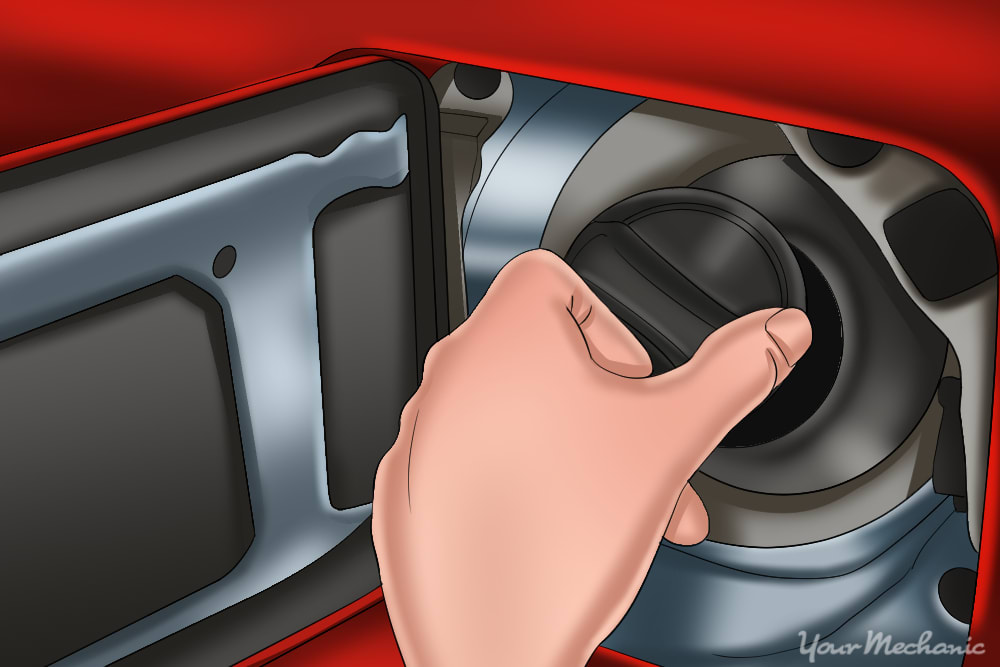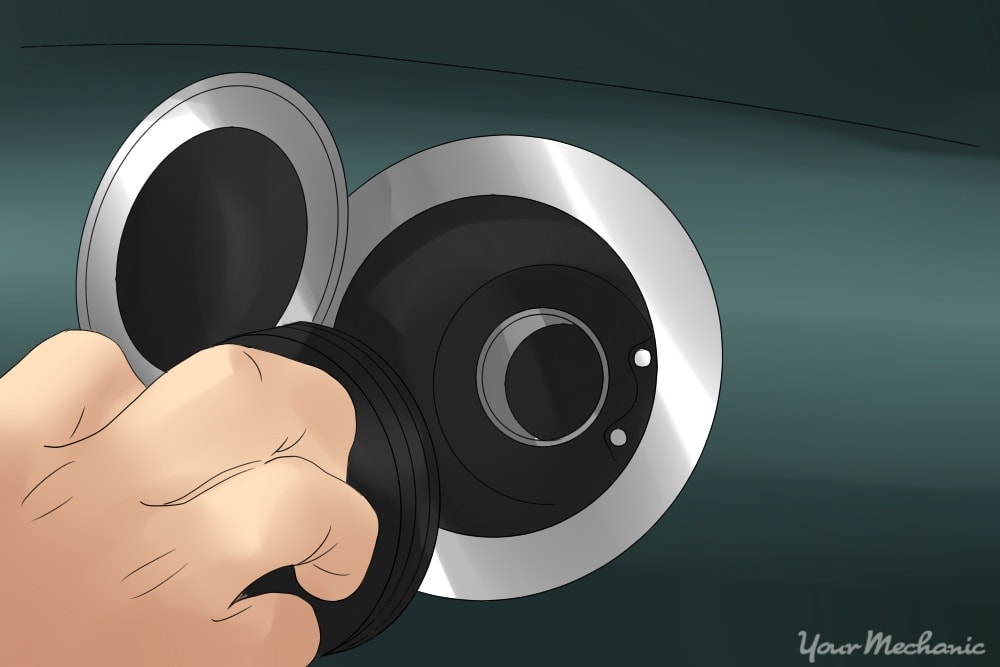

Arguably one of the least thought about mechanical components on any car is the gas or fuel cap. Funny enough, we typically remove and reinstall this simple plastic (or metal on older vehicles) piece of equipment any time we add fuel to our vehicles. As we place it back onto the fuel tank, the cap is supposed to "click" – as an indicator to the driver that the cap is secure.
But what happens when the cap doesn't go "click?" What are we supposed to do? How does it impact the operation of the vehicle? And, what can we do to troubleshoot why the gas cap doesn't "click"? In the information below, we'll answer all three questions and provide some resources that will help you determine why that small plastic piece isn't cooperating.
Method 1 of 3: Understanding the warning signs or a damaged gas cap
Before you can troubleshoot the cause of a problem, it's important to understand what task the component is designed to actually perform. According to most automotive experts, the fuel cell cap has two primary functions.
First, to prevent fuel or vapors found inside the fuel cell from escaping through the fill neck and second, to maintain a constant pressure inside the fuel cell. This pressure is what allows fuel to flow to the fuel pump, and eventually to power your vehicle. When the gas cap is damaged, it loses its ability to maintain the seal on the fuel cell as well as reducing the amount of pressure inside the gas tank.
On older vehicles, if this occurred, it was more of an inconvenience. However, as the modern day ECM was introduced and sensors found themselves monitoring virtually every component on the vehicle, a loose or broken gas cap can cause multiple issues that will negatively impact the operation and performance of your vehicle.
In many cases, when the gas cap is damaged and won't "click" when it's placed back onto the fuel tank, it will cause a few warning signs to pop up. Some of the more common indicators of a bad gas cap may include the following:
Inability to start the engine: In many worst case scenarios, when the gas cap does not maintain a seal or the correct pressure inside the tank, a sensor will trigger an alert to the vehicles ECM and literally shut down fuel flow to the engine. Without fuel, a motor can't operate.
Rough idling engine: In some situations, the engine will run, but it will idle and accelerate extremely rough. This is typically caused by the inconsistent flow of fuel to the engine because of the reduced or fluctuating fuel pressure inside the gas tank.
Will trigger the check engine or gas cap light along with several error codes: In most circumstances, the loose fitting gas cap, or if it doesn't "click" when installed, will trigger a few OBD-II error codes to be stored inside the vehicles ECM. When this happens, the most logical action is for the check engine or gas cap light to illuminate on the dashboard or instrument cluster.
In many cases, the error codes that will be triggered by a loose fitting gas cap will include the following:
Each of these codes has a specific description that can be interpreted by a professional mechanic with a digital scan tool.
Method 2 of 3: Inspect the gas cap for damage
If any of the above symptoms has occurred, or if you are installing the gas cap and notice that it simply doesn't "click" like it usually does, the next step should be to physically inspect the gas cap. In most cases, the reason the gas cap does not click is due to damage on some part of the gas cap.
On modern day vehicles, the gas cap is comprised of a few individual parts including:
The pressure relief valve: The most important part of the modern day gas cap is the pressure relief valve. This part is located inside the gas cap and is what allows small amounts of pressure to be released from the cap in cases where the tank is building excessive pressure. In many cases, the "clicking" sound you are hearing is caused by this pressure valve resetting itself.
The gasket: Underneath the gas cap is a rubber gasket that is designed to create a seal between the base of the fuel filler neck and the gas cap. This part is typically the component that is damaged due to excessive removals. If the gas cap gasket is pinched, dirty, cracked or broken, it can cause the gas cap to not seal properly and most likely will not "click."
There are a few other parts but they don't impact the caps ability to secure onto the gas tank. If the parts above that will cause the gas cap to not "click" are damaged, the gas cap will need to be replaced. Fortunately, gas caps are fairly inexpensive and incredibly easy to replace.
In fact, it's starting to become an important part of routine maintenance and service; as more and more manufacturers are including it in maintenance programs. It's a good idea to replace your gas cap every 50,000 miles.
To inspect the gas cap for damage, follow the steps noted below but remember, each gas cap is unique to the vehicle; so refer to your vehicle service manual for exact steps if it's available.
Step 1: Inspect the gas cap for damage on the gasket: The quickest way to troubleshoot a gas cap that won't click is to remove and inspect the gas cap gasket. To remove this gasket, simply use a flat blade screwdriver to pry the gasket over the gas cap housing and remove the gasket.
What you want to look for are any signs of gasket damage including:
- Cracking on any part of the gasket
- The gasket being pinched or rolled over before you removed it from the gas cap
- Broken parts of the gasket
- Any gasket material left on the gas cap after you removed the gasket
- Signs of excessive dirt, debris or other particles on the gasket or gas cap
If you notice that any of these issues are visible during your inspection, purchase a new recommended OEM gas cap and install the new one on your vehicle. Do not waste the time to purchase a new gasket, as it will eventually wear out or the gas cap will develop other issues.
Step 2: Inspect the pressure release valve: This test is a bit harder for the average consumer to perform. The pressure release valve is located inside the gas cap and unfortunately, can't be removed without breaking the cap. However, there is an easy test to determine if the release valve is damaged. Place your mouth over the center of the gas cap and suck or breathe into the gas cap. If you can hear what sounds like a "quack" from a duck, this means the seal is working correctly.
The gasket and the pressure relief valves are the only two components on the gas cap itself that will cause it to not "click" or tighten as it should. If these two parts check out OK, move onto to the final method listed below.
Method 3 of 3: Inspect the gas tank filler housing
In some very rare cases, the gas tank filler housing (or where the gas cap screws into) will become clogged with dirt, debris or the metal part will actually become damaged. The best way to determine if this part is the culprit is to follow these individual steps:
Step 1: Remove the gas cap from the filler housing.
Step 2: Inspect the tank filler housing. Inspect for signs of excess dirt, debris or scratch marks where the cap screws into the gas tank.
In some cases, especially on older gas tanks with metal gas caps, the cap may be installed crooked or cross threaded and creates a series of scratches on the tank housing. On most modern fuel cells, this simply isn't practical or possible.
**Step 3: Look for any obstructions on the fuel neck. As crazy as it sounds, sometimes foreign objects like a twig, leaf or other object will find its way into the fuel neck. This could cause a blockage or reduced connection between the gas cap and the fuel tank; which may cause the cap to not "click."
If the gas tank filler housing is damaged, it will need to be replaced by a professional mechanic. This is highly unlikely but can happen in some rare cases.
Under most circumstances, replacing the gas cap on any car, truck or SUV is very easy to complete. However, if the gas cap triggered an error code, it may need to be removed professionally by a mechanic with a digital scanner in order to get the car back running strong. If you need any assistance with a damaged gas cap or resetting error codes from a damaged gas cap, contact one of our local mechanics to complete your gas cap replacement service.




